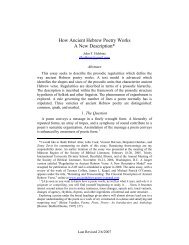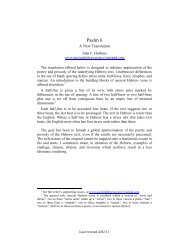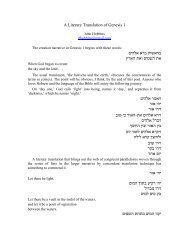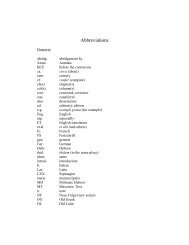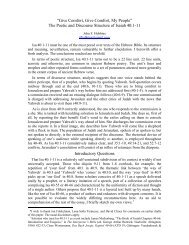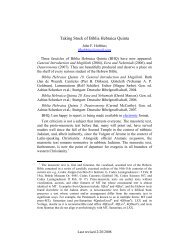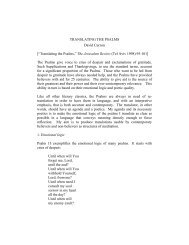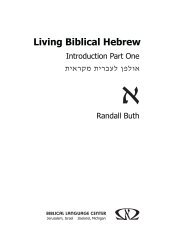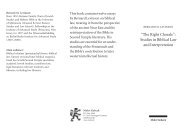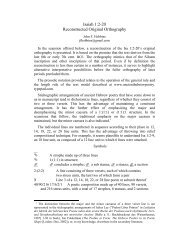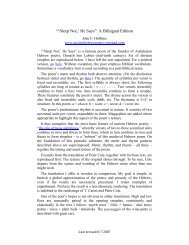Here - Ancient Hebrew Poetry - Typepad
Here - Ancient Hebrew Poetry - Typepad
Here - Ancient Hebrew Poetry - Typepad
- No tags were found...
Create successful ePaper yourself
Turn your PDF publications into a flip-book with our unique Google optimized e-Paper software.
31novel subdivision of a poem, or delimitation of the whole, is suggested.Discussions of examples appear elsewhere. 62The model is compatible with the phonology and stress patterns of ancient<strong>Hebrew</strong> insofar as we might reconstruct them. A sizeable corpus of ancient<strong>Hebrew</strong> inscriptions and texts beyond the <strong>Hebrew</strong> Bible from the First andSecond Temple Periods is now available, such that diachronic andsynchronic study of ancient <strong>Hebrew</strong> is on a firmer footing than before. Asthe language evolved, sound changes occurred and stress patterns changed,but the general rule and length rule are such that they did not necessarilyobsolesce as a result. A reconstruction of the phonology of 6th century BCE<strong>Hebrew</strong> is offered elsewhere. 63 Many unanswered questions remain, andprobably always will. The reconstruction of ancient <strong>Hebrew</strong> phonology isnonetheless a necessary propaedeutic to serious investigation of regularitiesin ancient <strong>Hebrew</strong> verse. More reconstructive attempts are a desideratum.The proposed text model is expressed within the framework of theprosodic structure hypothesis of contemporary linguistic theory. Thediscussion offered above is rudimentary. A fuller discussion appearselsewhere. 64 Linguists currently apply a variety of formal approaches topoetry. More formal linguistic analyses of ancient <strong>Hebrew</strong> poetry are adesideratum.The work of cross-linguistic comparison with Ugaritic, Aramaic,Phoenician, Punic, and Akkadian poetry, and with poetries farther removed,remains largely undone. The model promises to reveal conventions thatgoverned other ancient Semitic poetries. 6562 Analyses available to date: “Isaiah 1:2-20,” “Isaiah 1:21–2:5,” “Isaiah 5:1-7,” “Isaiah40:1-11,” “Jonah 2:3-10,” “Psalm 6,” “Psalm 8,” “Psalm 104,” “Psalms 111-112,” “Psalm137,” “Song of Songs 1:2-14,” and “Lamentations 1,” ancienthebrewpoetry.typepad.com.63 “In Search of Prosodic Domains.”64 “In Search of Prosodic Domains.”65 For preliminary observations, see the writer’s “Regularities in <strong>Ancient</strong> <strong>Hebrew</strong> Verse:An Overview,” ancienthebrewpoetry.typepad.com; and in reference to rule-constrainedvariation in verset and line length attested in other ancient poetries, fn. 53 above. Analysesof examples of Ugaritic and Aramaic poetry are in a preliminary stage of preparation.Analyses of examples from Ben Sira and Hodayot suggest that the general rule and thelength rule were still operative in <strong>Hebrew</strong> poetry of the Hellenistic period.



